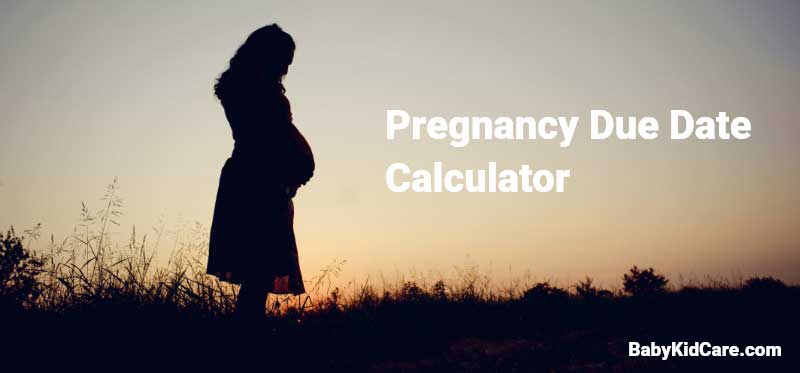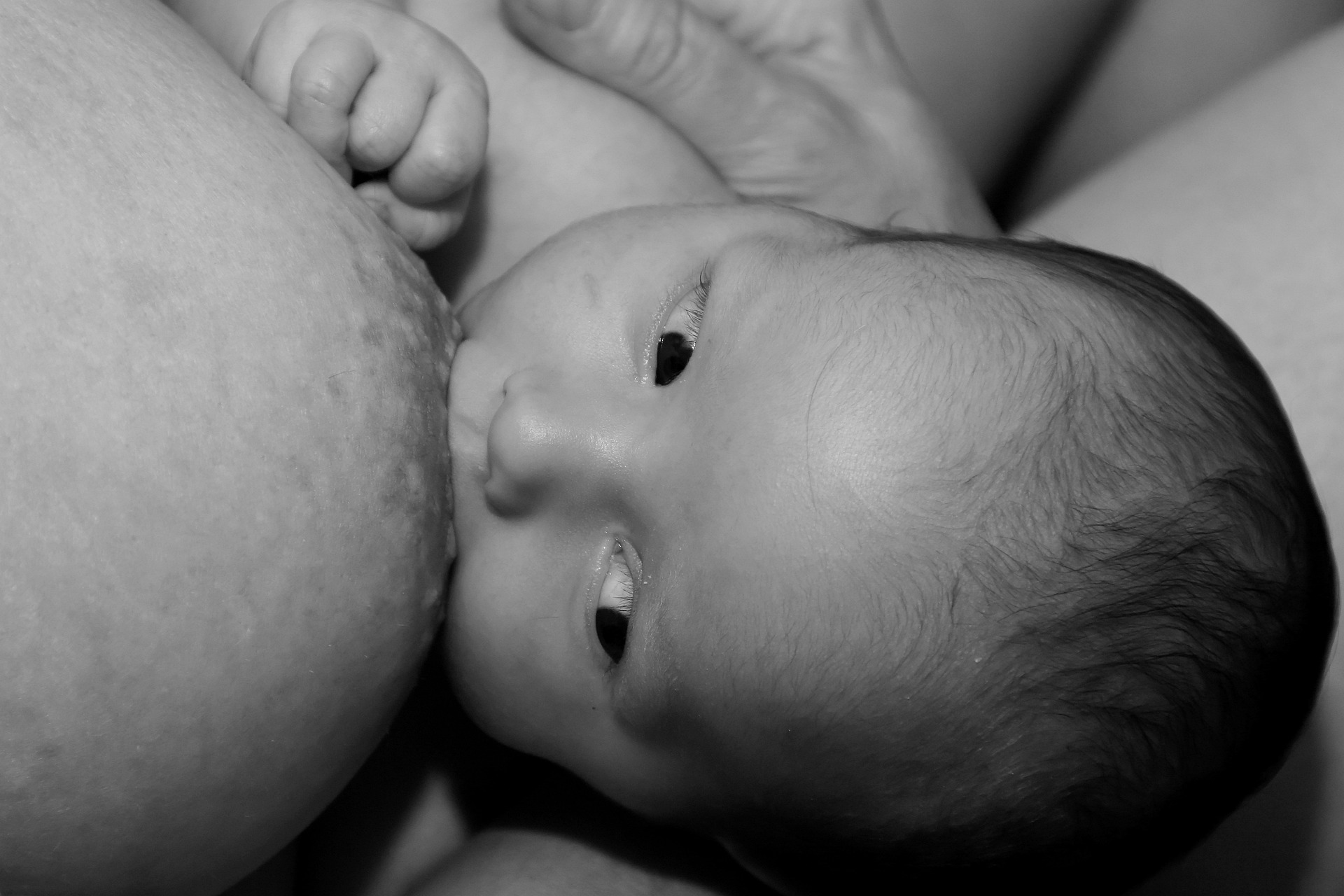Finding out you are pregnant can bring a mix of feelings and emotions all at once. You may experience joy, panic, surprise, anxiety, or even relief, which is all normal. Each of my four kids was different. My first one was fear in if I would do things correctly. The last one was if I had the energy to still keep up, knowing what lay ahead.
Unfortunately, some of these feelings may not be what you envisioned, probably because people don’t talk about them more often.
Table of Contents
- How to Calculate Last Period Date?
- How to Calculate Due Date or Due Date Calculator
- What is the Clear Blue Pregnancy Test?
- What is the First Signal Pregnancy Test?
- What Does it Mean When a Pregnancy Test Line Disappears?
- What Does a Blank Pregnancy Test Mean?
- How to Know when to take a Pregnancy Test?
- How to Fake a Pregnancy Test with Apple Juice
- Pregnancy Stages 9 Months Journey
- Final Thoughts
What’s more? If it’s your first pregnancy, you may not know what to expect or even how to calculate your due date.
But don’t fret because, in this article, we are going to discuss what you need to know about the stages of pregnancy. So, keep reading.
[clearblue-due-date-calculator]
How to Calculate Last Period Date?
Menstruation typically occurs in 28day cycles. However, some women have longer or shorter cycles, like 27 or 30 days.
The good news? If you are not sure about your period dates, you can use a period calculator. Of course, you will need to know your cycle duration, period duration, and the date of your last period.
This calculator will also help you know when you are most likely to get pregnant. Additionally, you can use it to estimate the exact date of your last period.
Probable Signs of Pregnancy
So, you recently had unprotected sex? And now your period is late than usual. Of course, you are probably wondering whether you could be pregnant?
Well, it can be hard to determine if your period is really late, especially if your cycle length varies a lot.
However, there are probable signs of pregnancy that could help you know if you’re actually pregnant. These are the signs commonly noted by a physician upon examination, and they include:
- Soft cervix
- Increased skin pigmentation in the areola, face, and/or stomach
- Abdominal bloating
- Increased frequency of urination
- Mild uterine cramping
- Increased basal body temperature
What to Know About Pregnancy Planner?
Planning your pregnancy comes with so many advantages. First, it allows you and your partner to adopt a healthier lifestyle. Consequently, you will be more likely to get a healthy baby.
Additionally, it allows you to save for your baby and shop smart. More importantly, planning pregnancy could make a big difference to your career.
However, when you become pregnant, you can also benefit from a pregnancy planner or journal. Basically, it can help keep you focused on pregnancy.
A pregnancy journal will help you document basic pregnancy information, including your thoughts and feelings about being pregnant. Other planners allow you to add photos like those of ultrasounds and even track information from your appointments.
What Exactly is the Conceived Date?
Conception is when the sperm travels up through the vagina, into the uterus, and fertilizes an egg. However, conception may happen shortly after sex or even several days later
Therefore, a conceived date is simply the day the sperm fertilized the egg. Unfortunately, it is hard to pinpoint the exact date of conception because of the many factors that surround conception.
Generally, conception is considered to occur around 11-21 days after the first day of the last period. However, this only happens to women with regular periods.
As such, estimating a conception date for women with irregular periods can be difficult. So, in this case, only an ultrasound exam can help estimate the conception date.
How to Calculate Due Date or Due Date Calculator
Just found out you’re pregnant and would like to know when your baby’s due? Well, there are several ways to calculate the due date.
For instance, if you know the day you conceived, you just need to count 38 weeks from that day. But if you don’t know the day of conception, there are other ways to estimate your due date. These include:
- First day of your last period
This method involves counting 40 weeks from the first day of your last menstrual period (LMP). It is the most common method that healthcare providers use.
- Conception date
If you know precisely when conception took place, you can determine your pregnancy’s due date. However, this method can only be effective for those that track their ovulation symptoms or use an ovulation predictor kit.
- IVF transfer date
For women that conceived through IVF, it’s possible to calculate the due date using the IVF transfer date. For example, if you had a Day 5 embryo transfer, you simply count 261 days from your transfer date. But if you had a Day 3 embryo transfer, you should count 263 days.
And you know what the best part is? You won’t need to calculate your due date by counting on your fingers, then adding and subtracting weeks. Thanks to pregnancy calculators like the Huggies’ due date calculator, you can quickly work out your approximate due date.
What is the Clear Blue Pregnancy Test?
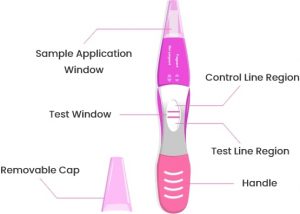
There are so many pregnancy tests available on the market to choose from. However, if you want fast results, the Clear Blue pregnancy test is the best. This is because the test is designed to deliver results in just 3 minutes or less.
Ideally, the test works by detecting a tiny amount of the hCG hormone in your urine. You see, when you’re pregnant, your body tends to produce the pregnancy hormone called human Chorionic Gonadotrophin (hCG).
When it comes to accuracy, this test is considered to be more than 99% accurate. However, it should only be used from the day your period is due.
Besides being fast and accurate, the clear blue pregnancy test is also easy to use. On top of that, it boasts an ergonomic handle, which makes it convenient to use. Also, the test boasts a color change tip that changes from white to pink when it comes into contact with urine.
What is the First Signal Pregnancy Test?
When you need a speedy, accurate, and reliable result, you should consider using the first signal pregnancy test. This easy-to-use test is designed to provide you with an answer almost instantly and the results are clear.
So, how does it work, you might wonder? Well, it’s simple. If you spot two red lines, it means you’re most likely pregnant. Compared to some tests, this kit can often detect a positive result even before you suspect that you’re already pregnant.
But what we really love about this test is that it is more than 99% accurate. More so, positive results may show as early as in one minute. The best part is that it requires just a small amount of urine.
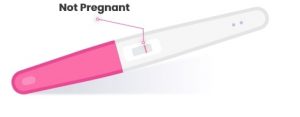
What Does it Mean When a Pregnancy Test Line Disappears?
When you finally spot a positive pregnancy test result, you’re bound to be absolutely elated. But what happens when you look at the test hours later, only to notice the line has disappeared?
Well, a pregnancy test line can disappear for many reasons so you should not freak out. Some of these include:
* Testing too early
If the pregnancy is too early, the hCG level in your urine may meet the threshold for being detected. This means you will see a faint line that can disappear over time. So, it’s recommended to wait a little longer to get the right results the first time.
*Waiting too long to read the results
It’s advisable not to wait too long before you read your pregnancy test results. This is because, if the test was not a strong positive, a faint line could fade if left for too long. So, make sure to interpret the results during the recommended time frame.
*Miscarriage
Sometimes a pregnancy loss can record a positive result and later change. When you have a miscarriage, your levels of hCG tend to drop. Therefore, over time, the intensity of the pregnancy test line will start to disappear.
What Does a Blank Pregnancy Test Mean?
Taking a pregnancy test brings mixed emotions like anxiety, tension, and anticipation. But now, imagine after enduring the agonizing minutes, you’re met by a blank pregnancy test. Well, it can be torturous since it is worse than a negative test result.
You see, a pregnancy test is designed to show results by the presence of lines. If two lines appear, you could be pregnant. But if it’s only a single line, then you’re probably not pregnant.
So, when the pregnancy test gives you the blanks, it could be that the test has lost its efficiency. As such, it could not interpret your urine’s composition. That said, here are some of the reasons for a blank pregnancy test result:
*Defective or expired pregnancy kit
One of the most probable reasons for a blank pregnancy test is that you might have used a faulty kit. Also, an expired pregnancy kit will give you a blank result since it’s not functional.
*Failure to follow the instructions
If you don’t read and follow the instructions on how to use the test, you could end up using it wrongly. As a result, the test result would be blank. Besides, various brands have different testing time frames.
*Dropping the kit while taking the test
When taking the test, urine needs to rise in the pregnancy kit by capillary action. Therefore, if you drop the test, the capillary action will be broken and urine will not rise. Consequently, you may end up with a blank test result.
How to Know when to take a Pregnancy Test?
Think you might be pregnant? Well, the only to be sure is to take an over-the-counter pregnancy test. But how do you tell when is the right time to take the test?
After all, you don’t want to take the test when is too early only to receive an inaccurate result. If you’re not sure when to take a pregnancy test, below are signs to watch out for.
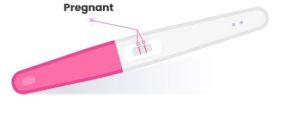
*Missed period
A missed period for sexually active women is one of the most common reasons to take a pregnancy test. However, it’s worth mentioning that periods can sometimes delay due to exercise, diet, medical conditions, or stress.
*Light Bleeding
Some women may experience light bleeding also known as implantation bleeding. This occurs when the embryo is attaching itself to the uterine wall. However, the bleeding is usually shorter and lighter compared to that of a menstrual period.
*Cramping
If you experience cramping around or before your period is due, you should take a pregnancy test. This is as long as there is no bleeding or the bleeding is lighter than usual.
*Nausea and vomiting
It may be a good idea to take a pregnancy test if you feel nauseous for no apparent reason. Nausea and vomiting are commonly associated with pregnancy and may occur between the second and eighth week.
*Changes in bathroom habits
Additionally, if you are experiencing gastrointestinal symptoms like gas, constipation, and bloating, you should get a pregnancy test. Some women may also deal with frequent urges to urinate.
How to Fake a Pregnancy Test with Apple Juice
Want to prank your partner with a positive pregnancy test even when you clearly know you’re not pregnant? You will be surprised to know that you can fake a pregnancy test with apple juice. Yeah, you heard that right!
Now you are probably wondering, how exactly do you do that? After all, apple juice does not contain HCG, which is the hormone present in the urine when you are pregnant.
Well, this is how this method works. Apparently, the hormones present in the urine when you are pregnant tend to be a bit sugary.
And since apple juice is also sugary, the sugars usually interact with the enzymes in the pregnancy kit. Consequently, this leads to a positive pregnancy test result. However, not all pregnancy test kits work with this method.
Pregnancy Stages 9 Months Journey
Typically, pregnancy is divided into three stages. This includes the first trimester, second trimester, and third trimester.
The first trimester goes until the 12th week, while the second trimester starts at 13 weeks and lasts until 27 weeks. The third trimester, on the other hand, starts about 28 weeks and lasts until birth.
In each of these stages, fetal growth and development happen. Also, your body tends to change along the way. Below, we’re going to discuss the pregnancy stages month by month so you know what to expect.
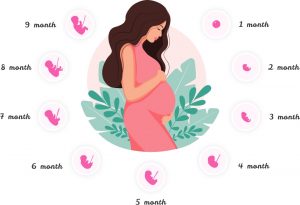
1st Month
The first month of pregnancy usually begins in the third week after your last menstrual period. During this time, you will experience several changes that will last throughout the first trimester of your pregnancy. These include:
- Nausea and vomiting
- Fatigue
- Food sensitivity
- Breast tenderness
- Frequent urination
However, these symptoms may differ from person to person. Additionally, you may experience light bleeding as implantation is taking place.
In this month, an amniotic sac will develop to cushion the growing embryo, as well as a placenta. And by the end of the month, your baby (embryo) will be about 1/4 inch longer.
2nd Month
Your physical changes during this month will be similar to those of the first month. But for some women, they may become more severe. Also, some women may develop other symptoms such as:
- Moodiness,
- Slight vagina discharge
- Acne
- Constipation
During this month, you may have your first prenatal visit. The doctor will give you an internal pelvic exam plus measure your weight gain, and blood pressure. Also, your urine will be tested for any infection and blood may be drawn to test for HIV and anemia.
By the end of this month, the fetus will be about 1 inch long and will weigh around 1/30 of an ounce.
3rd Month
This month marks the end of your first trimester. Most of the pregnancy symptoms you might have had in the second month will continue and may even worsen.
Your breasts will continue growing and changing. Additionally, the areola (the area around the nipple) may grow larger and darker.
During this month, your baby’s hands, arms, fingers, toes, and feet will be fully formed. More so, your baby’s reproductive organs will be formed and the heartbeat will be detected.
At the end of this month, your baby will be around 4 inches long and weigh about one ounce.
4th Month
The fourth month of pregnancy usually the start of the second trimester. During this time, hormones will start to stabilize and nausea will subside. As such, you will feel normal again.
However, digestive problems such as constipation and heartburn may be troublesome. You may also feel faint or dizzy because of changes in your blood vessels.
In this month, the baby will be about 6 inches long and may weigh up to 4 ounces. Also, the baby’s heart and face will be fully formed.
More importantly, the doctor will monitor the fetal heartbeat and size as well as your blood pressure and weight.
5th Month
Early this month, you may start to put on weight around your abdomen area. Your heart rate will also increase while the belly button may pop out as the uterus continues to grow.
On top of that, you may experience trouble breathing. The breasts will also continue to grow big and the nipples softer.
As if that’s not enough, the baby will become more active and will weigh around 10 ounces. When it comes to size, he/she will be about 6-9 inches long.
And since the baby will have developed the reproductive organs, the sex of the baby can be determined via ultrasound.
6th Month
In this month, your uterus will be almost the size of a basketball resting above your belly button. The skin around the stomach may also feel itchy as it stretches. More so, you may become tired more easily.
For some women, they may gain weight every week during this month. Unfortunately, this may result in varicose veins. Additionally, the breasts may start to produce colostrum or experience Braxton-hick contractions.
As far as the baby is concerned, the finger and toe prints will be visible. The eyes will also begin to open and close. More so, the vocal cords will be functional.
By the end of the month, the baby will measure around 12 inches in length and weigh over a pound. Therefore, if born prematurely, the baby may survive if placed under intensive care.
7th Month
In this month, your uterus will continue to expand, and you may experience back pain. Therefore, this is the best time to start thinking about maternity leave and birth plans.
During this month, your feet or hands may also start cramping. You will also experience more baby movements.
Additionally, your baby will tend to change positions frequently and even respond to stimuli like pain, light, or sound. It will also develop more fat on the skin.
Further, the baby will be around two to four pounds in weight and about 12 inches long. So, if born prematurely, he/she would likely survive.
8th Month
Here, you will continue to gain at least a pound a week. On top of that, you may feel discomfort as the baby pushes on the organs or rib cage. Other changes that you may experience include:
- Stretch marks may appear
- Increased pelvic pressure
- Heartburn and indigestion
- Regular Braxton hick contractions
Additionally, the baby’s brain and lungs will continue to develop rapidly. However, movements may reduce because there will be minimal room for the baby to stretch.
By the end of this month, your baby’s head could be heading down and descending into the pelvic area. And he will be about 12 inches long and weigh five pounds.
9th Month
During this month, the countdown to the baby’s birth will start. Therefore, you should have the nursery, clothes, and everything else you need for you and the baby ready.
However, sleeping will be more difficult and you may feel anxious about the upcoming birth. Also, you will have gained so much weight – around 35 pounds on average.
Additionally, you may feel tired one minute and energetic the next. When this happens, you will probably want to clean and decorate the house.
In this month, you will also need to be prepared as you could go into labor at any time. Generally, your baby will be about 18-20 inches long and weigh around 7 pounds.
In case you pass your due date at this point, it is recommended that you visit your caregiver for monitoring.
Final Thoughts
There you have it! A summary of everything you need to know about pregnancy. So, we hope you find the information helpful whether it is your first, second, or third pregnancy. Just make sure to use a reliable pregnancy kit when testing to confirm that you’re pregnant.
Sharon







